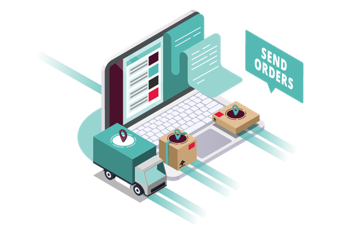A guide to selecting the right order management system
From automating manual tasks to providing data-driven insights, order management systems are a critical tool for retailers, 3PLs and warehouses to save time, reduce costs and satisfy growing customer demands.
When it comes to selecting an order management system, there have never been more options to choose from. While an abundance of choice is a good thing, it also means you must carefully weigh up the pros and cons of countless solutions to select the one best suited to your business.
The functionality and benefits offered by different solutions can vary significantly. Some features may not be useful for your business, while others could be essential.
In this guide, we outline what you should be looking for in a order management system, and what to avoid, to help you make the right choice.
Article content
- Order management systems defined
- 3 steps to begin your order management system selection process
- 10 must-have order management system capabilities
- 4 essential capabilities 3PLs need in an order management system
- 4 signs of a limited order management system
- Enhance your fulfilment capabilities with Access Mintsoft
Order management systems defined
So, what is an order management system? Put simply, it is software that helps ecommerce businesses track and streamline the order fulfilment process – from the point an order is received to the picking, packing and shipping process. The system provides a single place to track orders, manage inventory and warehouse operations, plus access data-driven fulfilment insights.
With the right system, you can speed up the fulfilment process by eliminating spreadsheets and automating many manual, error-prone tasks. It can also centralise and simplify multi-channel selling by integrating marketplaces, couriers and other software solutions in one platform.
3 steps to begin your order management system selection process
Given the multitude of order management systems available, it is critical to do your research to work out which one best caters to your business’s unique needs. Here, we outline three initial steps you can take to narrow down your options and identify the right solution:
Establish your ideal price
Your decision will of course be guided by your budget. It is therefore important to work out the ideal price for your order management system and thereby eliminate all those options outside of your budget. While considering your ideal price, remember that your initial investment in a system will be offset by the cost and time efficiencies it can deliver. Automation capabilities, for instance, will help save significant time by eliminating many manual tasks, in addition to the time often spent correcting human error. Just this alone could offset your initial investment after only a few months.
Outline pre-requisite features
Order management software can vary significantly in functionality, so an effective way to narrow down your options is to create a list of all those features you cannot do without. For instance, mobile barcode scanning may be a feature that you need at all costs. Or it may be that you require the ability to add your branding to customer documents like invoices. Also consider those features that you do not require. You may be impressed by a system that offers a multitude of capabilities, but if you are unlikely to use them, it is likely not worth the extra cost.
Plan ahead
When assessing your options, make sure to consider not only your business’s current needs, but also those that may arise as it grows. The last thing you want is to outgrow your solution and incur the significant time and financial costs of switching to another after only a few years. One feature to keep a lookout for in an order management system is API connectivity and third-party integrations, as this allows you to connect other software solutions and ecommerce platforms, therefore expanding your capabilities as business needs evolve.
10 must-have order management system capabilities
With so many solutions on the market, it is challenging to work out which features that you really need, and those you do not – both now and in the future. To help you out, here we provide a list of the most important features that ecommerce businesses typically require as a minimum. The right system should allow you to:
1: Monitor order progress
Your ideal system should provide visibility of order progress from when it is placed by the customer, to its handling in your warehouse and delivery. The system should not only provide you with this visibility, but also the customer. Make sure it offers the ability to easily send notifications to customers so that they are always up-to-date on the progress of their order and when they will receive it.
2: Easily manage stock
An inventory management module is critical for ecommerce businesses to maintain an optimal amount of stock so that orders can always be fulfilled. It can automatically monitor inventory levels and sales so they are in sync, which ensures all your sales channels are up to date.
Inventory management capabilities can also automatically route orders to particular warehouses based on your stock levels or the delivery address. You can even set rules for how orders are packaged based on their value, weight or delivery method.
3: Expand worldwide
Branching out into overseas markets is an effective way to grow your business, but without the right fulfilment software, doing so can be challenging. That is why it is essential to have an order management system that makes international ecommerce easy. This means, for instance, that it gives you the ability to process orders and payments in multiple currencies.
4: Consolidate multiple systems
If your current setup requires you to manage multiple unintegrated platforms, you will want to choose an order management solution that can bring them all together. Leading solutions will offer API connectivity or built-in integrations with third-party platforms, like your accounting or warehouse management solutions, in addition to seamless connectivity with shopping carts and couriers.
This kind of integration means you and your team can save significant time and frustration by avoiding multiple log ins and having all your fulfilment and financial data consolidated in one platform.
5: Simplify shipping
Integration with multiple couriers and multi-carriers is a must for any order management system. As your business receives more and more orders, these services will help minimise costs and ensure reliable and timely deliveries. Some order management systems have courier management built in which allows you to automatically select the most cost-efficient and fastest shipping service.
6: Streamline multi-channel selling
An optimal system should offer seamless integration with online marketplaces like Amazon and eBay to simplify their management. Centralising all your marketplaces with multichannel listing in one platform gives you complete visibility and control of your orders, inventory levels and customer data, while minimising manual tasks.
7: Simplify dropshipping
Dropshipping is often an administrative nightmare, requiring many time-intensive manual tasks. It requires you to recall which products have been sent by which suppliers. Then, you need to copy and paste data to create invoices for each supplier. After this, you also have to send emails to both suppliers and customers.
With the right order management system, dropshipping is almost a set and forget undertaking. It allows you to create lists of dropshipping items and automatically splits out the items from orders that you do not fulfil yourself.
This makes it simple to know which orders you need to fulfil and which ones are covered by your supplier. The system can also automatically send emails to suppliers and customers as soon as you receive an order.
8: Adapt with customisation
Being highly customisable, a cloud-based system allows you to add features and modules as you need them, which means you do not have to pay for anything you do not need. Cloud software vendors generally provide multiple pricing plan options, each offering their own set of features. They also provide implementation and technical support to ensure you get the most out of your system.
9: Promote your brand
Branding the documents you send customers, like invoices, shipping labels and dispatch notes, is a simple yet powerful way to promote your business. A system that allows you to add your logo and company information to such documents makes it easy for customers to identify who sent their order and contact you if issues arise.
The best systems give you the ability to customise the information you provide customers, for instance, to not include an item’s price if it was ordered as a present.
10: Leverage cloud benefits
If you want a solution that can grow along with your business, cloud-based software is the way to go. Not only does it offer the flexibility to adapt to your changing needs, it also provides anywhere, anytime accessibility and better performance and reliability compared to single-server solutions.
Cloud-based systems also offer higher security than on-premise solutions, with security updates as well as those that add functionality improvements automatically applied in the cloud. Plus, there is no need to invest in a private server or IT maintenance, as your solution and all your data is secured in the cloud by your software vendor.
4 essential capabilities 3PLs need in an order management system
Australian online retail sales continue to rise. In 2022, they represented 18.1% of total retail spend. In 2023, it is projected that a third of all retail sales will take place online.[1] 3PLs play a critical role in helping ecommerce businesses capitalise on this online selling opportunity, with many utilising order management systems to enhance their services. So, what critical capabilities should 3PLs look out for in a system? Make sure it provides the ability to:
Service multiple sectors
A large part of the efficiencies you can gain from an order management system comes down to its integration with multiple third-party ecommerce platforms. This means that you can easily service customers across a range of sectors, with the ability to consolidate all your processes across multiple platforms in a single, easy-to-use solution.
Satisfy growing client demands
The expectations of customers are ever-increasing and changing. So, you need a system with the flexibility and features required to swiftly adapt to their needs. Being able to automate your fulfilment operations is one thing. But if your system does not provide the ability to offer clients a range of shipping choices, payment in their currency or a swift returns process, your 3PL business will struggle to adapt to their needs.
Handle seasonal changes
Customer demand can fluctuate in many sectors, which means that inventory management is an essential feature to look out for in a system. The best order management systems can automatically monitor and forecast inventory requirements, so you can ensure you always have the right amount of stock on hand.
Boost capacity as you grow
If your business outgrows the capabilities of your order management system, it means facing the lengthy and costly prospect of migrating to a new solution. That is why it is so important to ensure the system you choose has the flexibility and scalability to grow along with your business. Again, a solution that offers seamless integrations with multiple platforms, in addition to the ability to add new features, is the way to go.
[1] Australia Post, 2023 eCommerce Industry Report: Inside Australian Online Shopping
4 signs of a limited order management system
By now, you should have a good idea of capabilities to look out for in an order management system. To help narrow down your search even more, here we share the main signs that a system offers limited capabilities and is unlikely to solve your business’s challenges. This includes if it:
Isn’t cloud-based
Using an on-premise order management system means you will be burdened not only with a hefty upfront license fee, but also the costly need to maintain your own local server. This is not required with a cloud-based system, which offer comparatively lower monthly or yearly subscriptions fees.
Plus, all your data is stored in your vendor’s cloud, which provides greater security than a local server set up. Cloud-based solutions also offer access from anywhere, at any time, removing the need to log on to a server that only provides access from one location.
Is challenging to implement
Implementations for some systems are more complex than others. Plus, not all vendors provide the support and training needed to get you up and running as quickly as possible. The more complex the implementation, the longer and costlier it is. So when considering a system, make sure to check with the vendor about the length and cost of an implementation, as well as if they provide comprehensive onboarding and ongoing technical support for your team.
Lacks integrations
It is critical to ensure that your new order management system offers integration with the platforms you are currently using. For instance, if your website was built using Magento, your order management system must offer Magento integration. If not, you will need to undertake a very time-intensive migration of all your products to another shopping cart.
Another warning sign that a prospective system may cause integration issues is if it does not offer API functionality, which is crucial to connect other critical business solutions, like your accounting software.
Can’t adapt to changing needs
After implementing a new system, the last thing you want is to have to switch to another system six months down the track. This is a very real prospect if you choose a system that does not allow you to add new features and modules like, for instance, warehouse management capabilities.
Again, a system that offers integrations with ecommerce platforms and API functionality will ensure you can continuously expand your fulfilment capabilities and avoid the hassle of using multiple disparate solutions.
Enhance your fulfilment capabilities with Access Mintsoft
Choosing a cloud-based order management system that is easy to implement, offers countless integrations and can evolve with your business is key.
Access Mintsoft offers all this and much more. This cloud-based solution comes with 175+ pre-built integrations with leading couriers, multi-carriers and marketplaces, plus API functionality so you can integrate your core business systems.
Via an affordable monthly subscription, you can choose the features you need and will always have the option to add more as your business grows. Plus, our FlightPaths service expedites your Access Mintsoft implementation so you can start benefitting from its powerful automation capabilities as soon as possible.
CASE STUDY | How Black Bear Fulfillment benefited from Mintsoft OMS
Black Bear Fulfillment have a simple mission: To provide the high levels of fulfillment service to Australian customers, which they experienced as a former eCommerce seller in the US and UK. An eCommerce 3PL specialising in smaller consumer items, such as clothing and cosmetics, Black Bear Fulfillment are 100% Australian owned and operated. They are based in Melbourne and employ more than 40 people after launching just three years ago.
Unlike most 3PL’s they aren’t just focused on the logistics and warehousing side of the business, but also, importantly, the customer. Fulfillment is about people as much as it is logistics, and they needed a software solution to help bring this customer-centric vision to life.
Case Study
Read the Black Bear Fulfillment case study to learn more about how this Australian 3PL has leveraged the power of the Mintsoft solution to grow their business and deliver a world-class customer experience.
Want to know more?
Have a read through more order management resources, guidance and advice.



